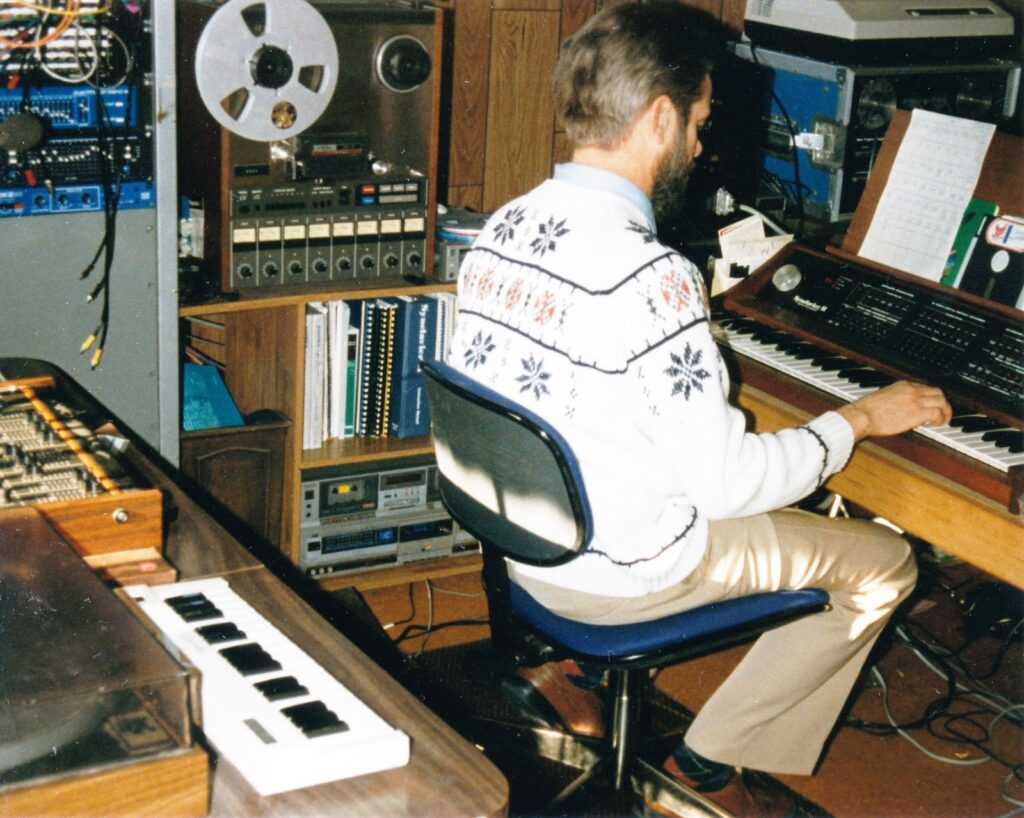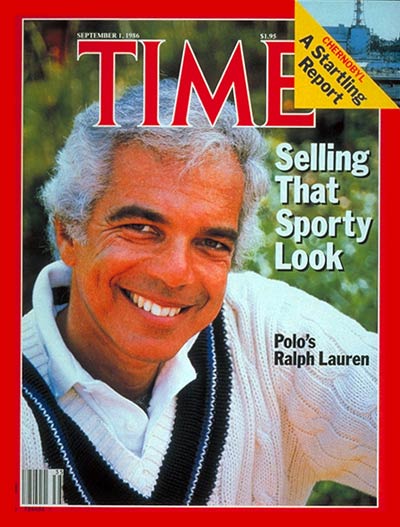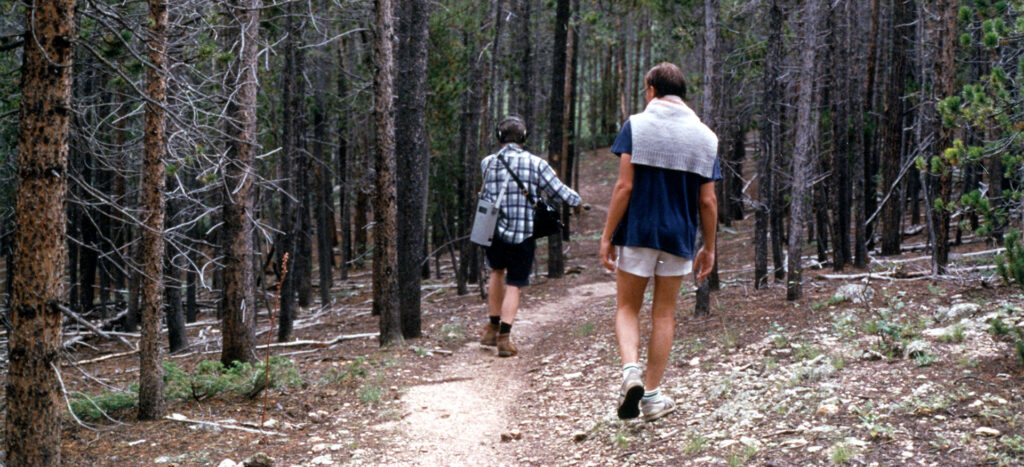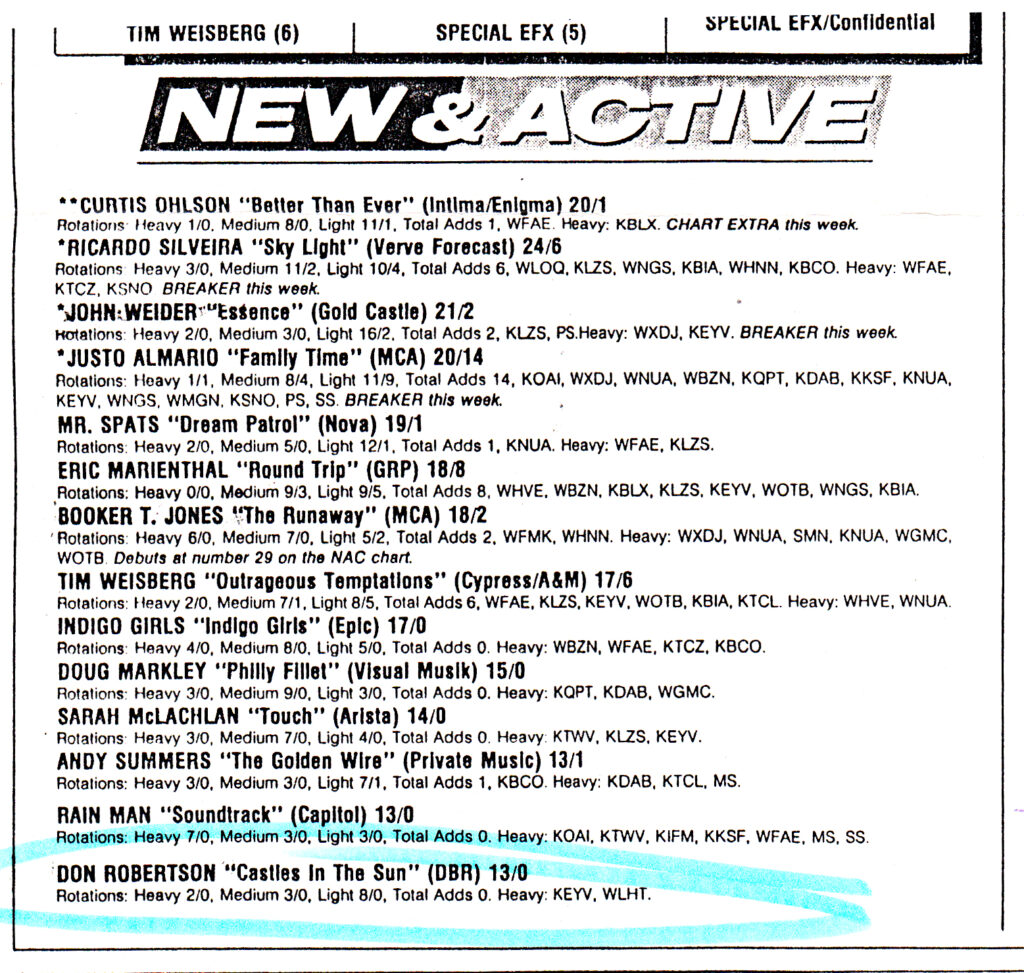The Genesis of New Age Music
Part Five - Corporate Takeover
From the online book: Music Through the Centuries by Don Robertson (2005)
Published on DoveSong.com – Revised and expanded in 2016 and 2024
Chapter Six – The 20th Century: “Dissolution”
Part One
The Dawn
The dawn of the concept of new-age music and the first major records of music for meditation and relaxation.
Part Two
Hearts of Space
A radio program in Berkeley becomes a phenomenon, bringing new music to the nation.
Part Three
Digital Symphonies
The advent of innovative, mind-expanding, meditative positive electronic music from Europe.
Part Four
California
Music artists in California form an influential and important genre of new music for healing and meditation.
Part Five
Corporate Takeover
Now called “new-age music”, the new music genre is hijacked by corporate media and the major record labels.
Rocky Mountain High
I relocated my family to Fort Collins, Colorado, in July, 1984… far away from the maddening new-age crowds. Fort Collins at that time was a cow town, where ordinary folks lived.
For two years my ex-wife and I built our “DBR Music” business. By 1986, we had over a dozen distributors selling my cassette albums and Spring LP. We sent large boxes of tapes to cities all over America on a daily basis and to Australia and Europe as well. We sold over 22,000 cassettes of Starmusic alone.
Stephen Hill from “Music from the Hearts of Space” was the audio engineer who had mixed this composition from my Starmusic album:
“Horizons Beyond Infinity” from Starmusic

The New Age Artist Collective
We had just moved to Colorado when myself along with the community of new age music artists in the Bay Area (Iasos, Xolotl, Ray Lynch, Connie Demby, Aeoliah, among others) were working to put the fledgling genre of new age music onto the national map. CBS Records was looking for new age artists, and we were working with a woman who called herself Isis. She was negotiating with CBS Records, setting up record deals. We assumed that soon we would all be signed to the CBS label, but that didn’t materialize.
I continued to work on my “masterpiece album” Anthem. However, with the prospect of a deal with a major record label seemingly looming ahead, I went to work on an album that would be more commercial, in more of a popular instrumental music vein, and I called this new project Castles in the Sun after one of the titles that I was recording for the album.
When I had completed the album, I heard Ray Lynch’s album Deep Breakfast, and I was blown away. It was amazing. Ray had come up with the perfect new age album, I thought. It had popular appeal, and it was selling like crazy.
Ray Lynch – “Celestial Soda Pop” from the album Deep Breakfast
This caused me to change my plans for Castles in the Sun. I compared it to Ray’s album and decided mine wasn’t commercial enough, and so I did something I will never do again. I created three pieces of music solely for the purpose of commercial appeal, and set aside music that I had already composed and recorded. I created these three pieces intellectually instead of allowing inspiration to create the music for me, as I had always done before, and always will do after. In 2018, I fixed this problem, restoring the album to its original glory in a new release on CD.
The opening of the original Castles in the Sun album
The opening of the 2018 Castles in the Sun album
New Age Music Goes National
We, the original new-age musicians, wanted our music to be accepted nationally in order to reach a wider audience. We were waiting for two events that we knew would trigger this national exposure: recognition by the mass media, and a radio station that would change its format to playing new-age music only.
The main event that we were awaiting, the event that we knew would trigger what we had been waiting years for, was the inevitable article in TIME Magazine, the corporate-controlled “news weekly” that at that time was so widely read that it literally controlled the opinions of the masses. Every week, it featured something “news-worthy” in its music section. National music trends were begun on the pages of this magazine, and we knew that the rapidly growing new-age music genre would appear in this popular magazine sooner or later. This would be the article that would “put us on the map”, moving us from book stores into the national record-store distribution network with our own “new-age” section in every mall record store in America. This inevitable article was rapidly approaching.
The Big Corporate Ripoff
In August, 1986, I got a call from Anna Turner of the “Music from the Hearts of Space” radio show. She was excited, telling me that a TIME Magazine reporter had just spent several days with her and Stephen Hill, and that the long-awaited article introducing new-age music to America was going to appear in the music section of the magazine in a few weeks! Time magazine was the most influential news magazine in America at a time when people got their in-depth news coverage from print as well as main-stream television and radio networks.
It looked like the big turning point had now arrived, the one that we new-age musicians had been waiting for and working towards.

Indeed, in a few weeks the article appeared in TIME Magazine. However, much to our shock and chagrin, the San Francisco Bay Area new-age musicians and the new-age musicians in the Los Angeles area were almost completely excluded from the article! Stephen and Anna and their Music from the Hearts of Space radio program, the very heart of the genre, were never mentioned in the article at all.
Instead, the magazine, based in New York City, presented a completely false story about the genre, featuring musicians that none of us had ever heard of. And the article was not about meditation and healing music at all; instead it completely recreated the new-age music genre, redefining it as something other than what it really was. We were shocked and dismayed to watch the power of the press in action.
Except for the music of New Jersey synthesizer musician Don Slepian, we considered the New York City area to be a place where no new-age music could possibly exist. New-age music was a Californian and European phenomenon.
Here is the opening paragraph of the TIME article. It says it all!:
It has been called “aural wallpaper,” “music for the Birkenstock crowd” and “yuppie elevator music.” Its titles evoke a holistic, hot-tubbing world: Etosha — Private Music in the Land of Dry Water, Aerial Boundaries, Nirvana Road. Although its composers include musicians prominent in the rock avant-garde, it is marked by a meditative aesthetic whose goal is often creative anonymity. A laid-back synthesis of folk, jazz and classical influences, it is called, by rough convention, New Age music. But what exactly is it?
- TIME Magazine September 1, 1986
(Read the TIME Magazine article here)
Suddenly a Split Personality
The result of Time Magazine’s complete fabrication was the bifurcation of the new-age music genre. There was now not only the genre being sold in the metaphysical book stores – healing and meditation music – but also the genre that was being sold in the record shops, including dozens of Windham Hill albums and dozens of rock and jazz newbie artists flocking to the scene. While perusing the new-age-music section at Tower Records in New York City one day, I noticed that some of these new musicians had been hard-core rock musicians only months before. Clearly someone, or something, had taken advantage of us. I wondered what kind of nefarious deal was going on behind the scenes.
Narada
One of our larger distributors that we sold product to was called “Narada”. It had not taken this company long to surpass Ethan Edgecombe’s Fortuna distributorship to become the largest new-age-music distributor. And, like Ethan, they had launched their own record label.
Narada had begun telephoning me in 1984 offering to sign me to their label. I didn’t jump on the opportunity, but I was considering the possibility. They called quite frequently for a year. Finally, I told them that I was considering only signing with them for Europe, where they were operating through a company in Holland. I wanted to release my album Anthem in Europe, because I didn’t believe that it would be understood or welcomed in America. However, I was still struggling with recording my album Anthem at that time.
In the meantime, Narada released my Spring album on LP in Europe, through their operation in Holland. I never received any royalties and had no idea what was happening with my album in Europe, but I was told by friends that the LP and cassettes were available there. (Narada eventually told me that they had sold only 11 copies).
As I finished up the recording of Anthem, the final part in the recording process was adding the sound effects that open the music on Side One… nature sounds, and the sound of a steam locomotive as it rapidly approached my microphone, ushering in the beginning of the music itself… yes, a really different idea. I had envisioned all of these sounds on the album for some time, and I had recorded them digitally with my portable Sony PCM-F1 professional digital recorder that Hollywood sound designer Frank Serafine had introduced me to.
I had been sending Narada bits and pieces of Anthem. However, when I finished the album and sent them the final copy, and they heard the sound effects for the first time, they refused to accept the album unless the offending sounds were removed. I refused to change anything, and this was the end of my relationship with that company.
Meanwhile, I was conversing by telephone with my fellow artist friends who had already signed with Narada, hearing lots of woeful tales about their relationship with the company. Narada was sounding more like a band of thieves every day. I even heard tales of albums that Narada had released in Europe without informing the artists, who had not even signed with them.
When a year later I mentioned in a newsletter that Narada had called me for a year, wanting to sign me, and that I had turned them down, I got a call from someone at the company accusing me of lying. I was told that Narada had never had any interest in me, and if I didn’t stop spreading lies, they were going to sic their lawyers on me.
What finally happened to Narada? It was purchased by EMI, the huge music company, to be eventually sucked up by Universal Music Group, now the world’s largest music publishing company, the CEO of which is the brother of my late friend Nigel Grange (1947-2017).

“The Beginning of Time” from the album Anthem:
Higher Octave
In 1986, I received a call from a new company in Los Angeles calling themselves Higher Octave. They had just released their first album by an artist named Peter Davidson and wanted to sign me next. They flew me to Los Angeles and I spent a day with them. I liked them a lot. They were really nice people.
I played them the album that I was developing, Castles in the Sun, and they wanted to release it on their label. I just needed to finish recording it.

"The Wave"
We, the real musicians of the new-age music genre, had received a big blow when Time magazine decided to create a new record-store-friendly version of new-age music. Now came the second blow, when the first “all-new-age-music” radio station went on the air… an event that we had been anticipating, and that several people in San Francisco were actively trying to make happen.
The folks at Higher Octave in Los Angeles were really excited as they continued to give me updates on this very first “new-age” radio station that was going to go live in mid-February, 1987 there in Los Angeles. It was going to be called “The Wave”.

This was news that we all had been waiting for. Finally, people would be able to turn on their radios and hear healing and spiritually transformative music! We assumed that our efforts would transform music in America, and that the popular charts would soon become influenced by our music. Hard rock would disappear forever, while popular music returned to something positive like it had been before. The new age was here!
Hey, no accounting for naiveté.
As the going-live date for the The Wave approached, we all waited with bated breath. Finally the day arrived. I got a call from Matt at Higher Octave in Los Angeles. He appeared to be in shock! The Wave had gone on the air, but there was no new-age music being played on the station at all. Instead The Wave featured the kind of slow jazz music that by that time had become associated with Windham Hill. Anything slow and jazzy, you would hear playing on this new station.
With this latest change in the direction of new-age music, many new-age artists, labels, and radio shows started changing their formats. Even Stephen Hill apparently had to change the format of his “Hearts of Space” radio show just to keep up! Except in the niche market of the metaphysical bookstores, new-age music as we had known it was finished.
The nice folks at Higher Octave couldn’t take a chance with me or Castles in the Sun now. I knew that. Back to that lower octave they would probably have to go.
And so, Higher Octave and Narada both became big labels in the new-age genre and both were finally absorbed into the behemoth Universal Music Group, the giant music corporation that had gobbled up just about everything else.
The Grammys Jump on Board
The Grammys quickly added “new-age music” to their huge out-of-control lists of genres. For the first year (1987), the new-age grammy award went to jazz harpist Andreas Vollenweider, the next year to jazz musician Yusef Lateef, and in 1989 to the Windham Hill group called Shadowfax. The 1990 new-age-music grammy award went to rock-musician Peter Gabriel for a soundtrack that featured music from the “world” genre. I am in no way discrediting these fine artists, I am simply providing the facts. Our genre was hijacked by the corporate dictators: an example of what happens when gigantic corporations take hold of something, then promote it in their own fashion, feeding the people misinformation, and reinventing history along the way.
Releasing Castles in the Sun
Now that Higher Octave wasn’t interested in my music, it was up to me, my ex-wife, and our “DBR Music” home record label to release Castles in the Sun ourselves. And so we did… on compact disc and cassette in 1989. We hired a promoter in Los Angeles to plug the album. Castles in the Sun then went national, with hundreds of radio stations across the country playing my music. The song “Melissa” from the album even became a favorite on the Los Angeles Wave station, receiving heavy rotation at one point.
We were also selling thousands of CDs. One big order from a major distributor in California alone was for 900 units. I remember stacking box after box into the UPS truck outside of our door and realizing how big of an order that really was. Another order for 300 CDs went to the Hastings Department Store chain. Our album was a success.
But when I listened to my music in the context of the other music on the Wave, which was now national, I believe, I realized that I was out of the game, a game that I simply was not interested in playing anymore. I put away my studio equipment and went to work on Kopavi, my ballet for chorus and orchestra.

The song “Castles in the Sun” from the album of the same name.
Video and photos by Don Robertson.
The Battle of Yawn Knee
At this time, the musician known as Yanni was living in Minneapolis and had released his first album of synthesizer music on his own “basement” label in the mid-1980s. This album was an altogether different kind of electronic music than the music that the new-age musicians were creating, and he was selling it independently, just like us. It was not healing music, nor was it uplifting in my opinion.
When he sent copies to the new-age-music distributors, they didn’t know what to do with it. It wasn’t “new-age” music, but they began distributing it anyway. One of my distributor friends had talked with Yanni on the phone. Yanni, the distributor told me, was quick to explain that his music was in no way new-age music at all. In fact, he talked scornfully about new-age music. Yanni believed that he was just about the greatest musical genius ever, or something to that effect, I was told.
Quickly, the music industry got a hold of Yanni. We learned that he had moved his equipment to a fantastic home in Los Angeles, was living with a beautiful Hollywood TV star, and Yanni had now suddenly been transformed into Mr. New Age himself!
It's All Over Now, Baby Blew
The major labels and record distributors created new-age music sections in mall record stores across the country and began dumping into them, “new-age-music” CDs by unknown artists who had suddenly appeared out of nowhere.
This had created an interesting phenomenon where the record stores in America had sections of “new-age music” that had little or no resemblance to the music that was still being sold in the metaphysical book stores, now known as “new-age book stores”. Thus, there arose two types of new-age music: the metaphysical book stores retained the more “meditative and healing” music, while the record stores, along with radio, turned the genre into a new, and more lucrative, style of music.
Disgusted and discouraged, I left the scene and never looked back. I have no idea what has transpired in the “new-age music genre” after I left it in 1989. That is for others to write about….
They Have Left the Building
Anna Turner (1942 –1996)
Florian Fricke (1944 – 2001)
Edgar Froese (1944 – 2015)
Manuel Göttsching (1952 – 2022)
Klaus Schulze (1947 – 2022)
Vangelis (1943 – 2022)
Iasos (1947 – 2024)
Constance Demby (1939– 2021)
